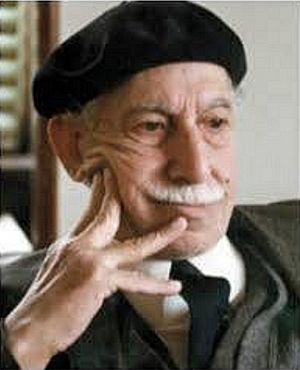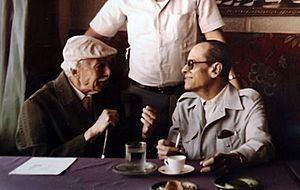Tawfiq al-Hakim facts for kids
Quick facts for kids
Tawfīq el-Hakīm
|
|
|---|---|

Undated photograph of Tawfiq al-Hakim
|
|
| Native name |
توفيق الحكيم
|
| Born | October 9, 1898 Alexandria, Khedivate of Egypt |
| Died | July 26, 1987 (aged 88) Cairo, Egypt |
| Occupation | Novelist, Playwright |
| Language | Arabic |
| Nationality | |
| Notable works | The People of the Cave |
|
|
|
Tawfiq al-Hakim (born October 9, 1898 – died July 26, 1987) was a very important Egyptian writer. He is known as one of the first people to write modern Arabic novels and plays. His many plays helped shape Egyptian drama. They also showed the challenges this type of writing faced in connecting with Egyptian society.
Contents
- The Early Life of Tawfiq al-Hakim
- Egyptian Plays Before Tawfiq al-Hakim
- Tawfiq al-Hakim's Wartime Writings
- Famous Plays by Tawfiq al-Hakim
- Tawfiq al-Hakim's Writing Style
- Tawfiq al-Hakim's Impact on Arabic Literature
- Tawfiq al-Hakim's Personal Life
- List of Works
- Film and TV Shows Based on His Works
- Images for kids
- See also
The Early Life of Tawfiq al-Hakim
Tawfiq Ismail al-Hakim was born in Alexandria, Egypt, on October 9, 1898. His father was a rich Egyptian judge. His mother was the daughter of a Turkish officer.
Tawfiq started primary school in Damanhour at age seven. In 1915, he moved to Cairo to finish secondary school. He lived there with his uncles.
Later, he went to Paris to study law. He even started a PhD. But he loved the theatres and opera in Paris more. After three years, he left his studies. He returned to Egypt in 1928. He had many new ideas for Egyptian theatre.
Egyptian Plays Before Tawfiq al-Hakim
Before Tawfiq al-Hakim, another great Egyptian writer helped drama grow. This was Ahmed Shawqi, known as the "Prince of Poets." He wrote several plays using themes from Egyptian and Islamic history. Some of his famous plays include The Death of Cleopatra (1929) and Driven mad by Layla (1931).
Tawfiq al-Hakim's Wartime Writings
During World War II, Tawfiq al-Hakim wrote many articles. He wrote against Nazism and Fascism. He showed Hitler as a bad figure. He believed Hitler's victory would end human civilization. He thought it would bring back "barbarism" and "beastliness."
He also wrote for Al Katib Al Misri. This was a literary magazine that started in Cairo in 1945.
Famous Plays by Tawfiq al-Hakim
His play, Ahl al-Kahf (The People of the Cave, 1933), was a big event in Egyptian drama. This story is found in the Qur'an. It is about seven sleepers who hide in a cave to escape persecution. They sleep for 300 years and wake up in a new world. This play explored big ideas like rebirth and returning to the past. Critics saw it as a very serious work.
A year later, al-Hakim wrote Shahrazad (Scheherazade, 1934). This play is set after the famous stories of One Thousand and One Nights. King Shahriyar, cured of his anger, seeks knowledge. He finds Shahrazad herself is a mystery. She is linked to the goddess Isis. She represents life and knowledge. Even though it's a great work, some critics thought it wasn't good for theatre.
When the National Theatre Troupe started in Egypt in 1935, they performed The People of the Cave. But the play was not a success. Audiences found the stage action too limited. This led al-Hakim to call his plays 'théâtre des idées'. These were works meant for reading, not just performing. Still, he kept writing plays with deep ideas. An example is Pygmalion (1942).
In 1945, al-Hakim started writing short plays for newspapers. These were collected into books like Theatre of Society (1950). One memorable play is Ughniyyat al-Mawt (Death Song). This play shows a family in Upper Egypt waiting for their son. He is expected to carry out a murder for a blood feud. This play became a short film starring Faten Hamama. Another play, Sahira (Witch), also became a popular short film.
After the Egyptian Revolution of 1952, al-Hakim wrote Al Aydi Al Na'imah (Soft Hands, 1954). This play is about a prince and a young academic. They both feel lost in the new society. The play shows how they find new roles. This play also became a popular film.
In 1960, he wrote Al Sultan Al-Ha'ir (The Perplexed Sultan). This play explores the idea of power and its rules. A powerful Mamluk sultan learns he was never legally freed. This means he cannot be a ruler. This play was brave for its time. It suggested that even powerful leaders must follow the law. It asked the ruling military government to use law, not violence.
Rosasa Fel Qalb (A Bullet in the Heart) was also performed in Cairo. It tells the story of Naguib, who is poor. He falls in love with Fifi, who turns out to be his friend's fiancée. This play had an open ending.
Tawfiq al-Hakim's Writing Style
Tawfiq al-Hakim's plays can be grouped into three types:
- Biographical Theatre: These plays were written early in his career. They showed his personal feelings about life. There were over 400 such plays. They were artistic because they shared his views on society.
- Intellectual Theatre: These plays were meant to be read, not acted. He published them as books.

- Objective Theatre: These plays aimed to help Egyptian society. They tried to improve values and show real Egyptian life.
Al-Hakim was good at showing nature. He used symbolism, reality, and imagination. He was skilled at telling stories, writing dialogue, and choosing settings.
His early plays used formal literary Arabic. But he experimented with different language styles. In Al-Safqah (The Deal, 1956), he used a "third language." This language could be read as standard Arabic. But it could also be understood by more people when performed.
One of his successful plays was Ya tali al-Shajarah (The Tree Climber, 1962). It used formal language in its dialogue. This added to the dream-like feel of the play. It showed a husband and wife who struggled to communicate. He continued to write plays in the 1960s. These include Masir Sorsar (The Fate of a Cockroach, 1966) and Bank al-Qalaq (Anxiety Bank, 1967).
Tawfiq al-Hakim's Impact on Arabic Literature
Tawfiq al-Hakim is a very important figure in modern Arabic literature. He is seen as the founder of modern Arabic theatre. He worked hard to develop Arabic drama. His efforts helped it become a central part of Egyptian political and social life.
His 1956 play Death Song was used for an opera. It became the basis for Mohammed Fairouz's 2008 opera Sumeida's Song.
Tawfiq al-Hakim's Personal Life
In his younger years, Tawfiq al-Hakim was called "Enemy of woman." This was because he wrote some articles that seemed to dislike women. He also stayed single for a long time. However, he eventually married. He had two children, a son and a daughter. His wife passed away in 1977. His son died in a car accident in 1978. Tawfiq al-Hakim died on July 23, 1987.
List of Works
- A Bullet in the Heart, 1926 (Plays)
- Leaving Paradise, 1926 (Plays)
- The Diary of a Country Prosecutor, 1933 (Novel)
- The People of the Cave, 1933 (Play)
- The Return of the Spirit, 1933 (Novel)
- Shahrazad, 1934 (Play)
- Muhammad the Prophet, 1936 (Biography)
- A Man without a Soul, 1937 (Play)
- A Sparrow from the East, 1938 (Novel)
- Ash'ab, 1938 (Novel)
- The Devil's Era, 1938 (Philosophical Stories)
- My Donkey told me, 1938 (Philosophical Essays)
- Praxa/The problem of ruling, 1939 (Play)
- The Dancer of the Temple, 1939 (Short Stories)
- Pygmalion, 1942
- Solomon the Wise, 1943
- Boss Kudrez's Building, 1948
- King Oedipus, 1949
- Soft Hands, 1954
- Equilibrium, 1955
- Isis, 1955
- The Deal, 1956
- The Sultan's Dilemma, 1960
- The Tree Climber, 1966
- The Fate of a Cockroach, 1966
- Anxiety Bank, 1967
- The Return of Consciousness, 1974
Film and TV Shows Based on His Works
- 1944: A Bullet in the Heart (film)
- 1960: The Holy Bond (film)
- 1963: Soft Hands (film)
- 1964: A Bullet in the Heart (play)
- 1964: Food for the Millions (Radio miniseries)
- 1967: Leaving Paradise (film)
- 1973: Death Song (Short film)
- 1973: Witch (Short film)
- 1976: The Quiet Nest (film)
- 1977: The Return of the Spirit (TV miniseries)
- 1986: A Sparrow from the East (film)
Images for kids
-
Naguib Mahfouz and Tawfiq al-Hakim in 1982
See also
 In Spanish: Tawfiq Al-Hakim para niños
In Spanish: Tawfiq Al-Hakim para niños



